 |
 |
 |
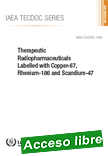 |
Therapeutic Radiopharmaceuticals Labelled with Copper-67, Rhenium-186 and Scandium-47
IAEA-TECDOC - 1945 ¦ 56 pages ¦ Date published: 2021
Theranostic radiopharmaceuticals have shown tremendous capabilities in the last decade in the treatment and diagnosis of human diseases via nuclear medicine procedures. In particular, the use of radiometals has experienced a great increase as a result of the development of relevant production technologies. This publication presents the outcome of an IAEA coordinated research project (CRP) focusing on the production, quality control and radiopharmaceutical aspects of three key radionuclides, 67CU, 186Re and 47Sc, which have been selected based on their theranostic potential and their dual production routes.
|
The publication was compiled using inputs from experts in the field as well as presenting the overall results of the CRP. It contains separate sections for each radionuclide including: nuclear data and information on targetry, irradiation, chemical separation, quality control as well as sample radiopharmaceutical production. The findings and considerations will be of use to scientists and technologists interested in translating research reactor and cyclotron based radioisotope production into practice, as well as to post graduate students in the field.
|
 |
 |
Guidelines for the Certification of Clinically Qualified Medical Physicists Endorsed by the International Medical Physics Certification Board (IMPCB) and the International Organization for Medical Physics (IOMP). Training Course Series No. 71
IAEA-TCS-71 ¦ 44 pages ¦ Date published: 2021
The International Medical Physics Certification Board was formed in 2010, with the main objective of supporting the practice of medical physics through a certification programme in accordance with the International Organization for Medical Physics guidelines.
|
Consultations with medical physics organizations and certification bodies have revealed a lack of international guidance in this area. To address this gap, in 2018 the IAEA convened a consultants’ meeting to prepare a publication highlighting the need for and benefits of medical physics certification, and providing information on the establishment of national or regional certification schemes. This publication builds on the experience and lessons learned from professional organizations and certification bodies and provides information on certification pathways in different scenarios. It is addressed to medical physics professionals and residents; medical practitioners in radiotherapy, nuclear medicine, and diagnostic and interventional radiology; health authorities and hospital administrators; and radiation protection regulatory agencies. This publication has been endorsed by the International Medical Physics Certification Board and the International Organization for Medical Physics.
|
 |
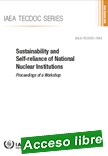 |
Sustainability and Self-reliance of National Nuclear Institutions. Proceedings of a Workshop
IAEA -TECDOC-1943 ¦ English ¦ 126 p. ¦ Date published: 2021
National nuclear institutes (NNIs) contribute significantly to national development, providing services focused on developing and applying relevant technologies for the public good. While many NNIs provide commercial services and products that generate revenue, some are financially dependent on subsidies from national governments. This publication presents the outcome of a workshop which addressed the challenges for Member States regarding self-reliance and sustainability of their NNIs.
|
Participants discussed efforts and best practices to cope with these challenges. The publication includes positive examples of tools or measures to be used in practical projects and programmes for achieving management goals towards self-reliance and sustainability. Examples of governmental policies in support of self-reliance and sustainability of NNIs are also presented. Finally, the country presentations in this publication show some examples of how NNIs cooperate with public or private stakeholders, providing some insights on how partnership opportunities can be explored.
|
 |
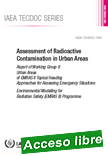 |
Assessment of Radioactive Contamination in Urban Areas
Report of Working Group 9 Urban Areas of EMRAS II Topical Heading Approaches for Assessing Emergency Situations
Environmental Modelling for Radiation Safety (EMRAS II) Programme. IAEA TECDOC No. 1941
English ¦ 406 pages ¦ Date published: 2021
Radiological environmental impact assessment models are important tools to ensure protection of the public and the environment. The IAEA has an ongoing programme to improve capabilities in this area by model testing and comparison, reaching consensus on modelling philosophies, approaches and parameter values.
|
This publication describes and summarizes the findings of Working Group 9 carried out during the IAEA EMRAS II (Environmental Modelling for Radiation Safety) programme. The results presented draw on international model validation exercises conducted to test and improve the predictive ability of models used for the assessment of radioactive contamination in urban settings, including dispersion and deposition events, short and long term contaminant redistribution following deposition events, and the effectiveness of potential countermeasures (protective actions, including remedial actions) for reducing human exposures.
|
 |
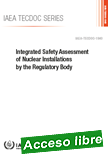 |
Integrated Safety Assessment of Nuclear Installations by the Regulatory Body
English ¦ IAEA-TECDOC-1940 ¦ 70 pages ¦ Date published: 2021
The effectiveness of nuclear regulatory systems is enhanced by portraying transparency and openness in communicating all matters relating to safety to the public and stakeholders. This plays an important role in maintaining and enhancing public confidence on the safe use of nuclear energy for socioeconomic development.
|
The regulatory body, in presenting the comprehensive safety status of nuclear installations, can use the outcome of integrated safety assessment mechanism which considers all important aspects of safety, with openness and transparency. This data driven process provides the public, relevant organizations and decision makers with comprehensive information on safety and regulatory decisions related to nuclear installations and is intended to provide a strong basis for, confidence in the regulatory decisions and information system. This publication provides practical information on the development of an integrated safety assessment mechanism by the regulatory bodies for nuclear installations. The integrated safety assessment model proposed in the publication comprises three steps: organizing input data for integrated safety assessment, trending and analysis, and development of overall results and conclusions.
|
 |
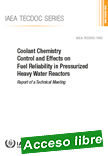 |
Coolant Chemistry Control and Effects on Fuel Reliability in Pressurized Heavy Water Reactors. Report of a Technical Meeting
English ¦ IAEA-TECDOC-1942 ¦ 126 pages ¦ Date published: 2021
Providing useful information on optimized chemistry control for pressurized heavy water reactors (PHWRs), this publication presents up to date knowledge on the topic including corrosion phenomena observed in the primary heat transport system and consequent effects on fuel reliability in PHWRs.
|
Specifically, it describes the national practices on coolant chemistry control under various operating conditions and research and development programmes aiming to understand the corrosion phenomena (formation and transport) and related chemistry control. Crud deposit on the fuel cladding, the influence on fuel fitness-for-service in the primary heat transport system, as well as the technical basis for remedial actions to ensure reliable fuel performance in PHWRs are considered.
|
 |
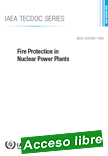 |
Fire Protection in Nuclear Power Plants
IAEA TECDOC No. 1944
English ¦ IAEA-TECDOC-1944 ¦ 120 pages ¦ Date published: 2021
Considerable progress has been made over the past several decades in the design and regulatory requirements for fire safety, in fire protection technology and in related analytical techniques. Substantial efforts have been undertaken worldwide to implement these advances in the interest of improving fire safety in both new and operating nuclear power plants (NPPs).
|
This publication provides information and insights on lessons identified, and best practices to reflect the recent status of the worldwide nuclear power industry and to provide further detailed guidelines and assistance in enhancing the fire safety of operating NPPs.
|
 |
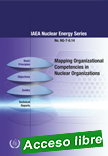 |
Mapping Organizational Competencies in Nuclear Organizations
IAEA Nuclear Energy Series No. NG-T-6.14
English ¦ STI/PUB/1844¦ 35 pages ¦ Date published: 2020
This publication outlines the concepts and models supporting the requirements for understanding organizational competence within the nuclear context. It aims to help in the development of organizational competencies in countries with an existing nuclear power capability and those wishing to embark on a nuclear power programme. The publication summarizes necessary processes for mapping organizational competencies, as well as tools and techniques used for assessing them.
|
Specific information provided in this publication will help organizations to determine competence needs based on strategic/corporate objectives and business processes, and to identify their existing success factors.
|
 |
 |
Nuclear Medicine Resources Manual: 2020 Edition
IAEA Human Health Series No. 37
English ¦ STI/PUB/1861 ¦ 175 pages ¦ Date published: 2020
Medical imaging is crucial in a variety of medical settings and at all levels of health care. In public health and preventive medicine as well as in both curative and palliative care, effective decisions depend on correct diagnoses. This edition addresses the most current needs and offers guidance on clinical practice, radiation safety and patient protection, human resource development and training required for the overall practice of nuclear medicine.
|
.
|
 |
 |
Mapping Organizational Competences in Nuclear Organizations
IAEA Nuclear Energy Series NG-T-6.14
English ¦ STI/PUB/1844 ¦ 35 pages ¦ Date published: 2020
This publication outlines the concepts and models supporting the requirements for understanding organizational competence within the nuclear context. It aims to help in the development of organizational competencies in countries with an existing nuclear power capability and those wishing to embark on a nuclear power programme. The publication summarizes necessary processes for mapping organizational competencies, as well as tools and techniques used for assessing them.
|
Specific information provided in this publication will help organizations to determine competence needs based on strategic/corporate objectives and business processes, and to identify their existing success factors.
|
 |
| |
|
|

|
|
|
| |
|
|
| |
| |
|
|
| |
| |
|
|
| |
| |
|
|
|
| |
| |
